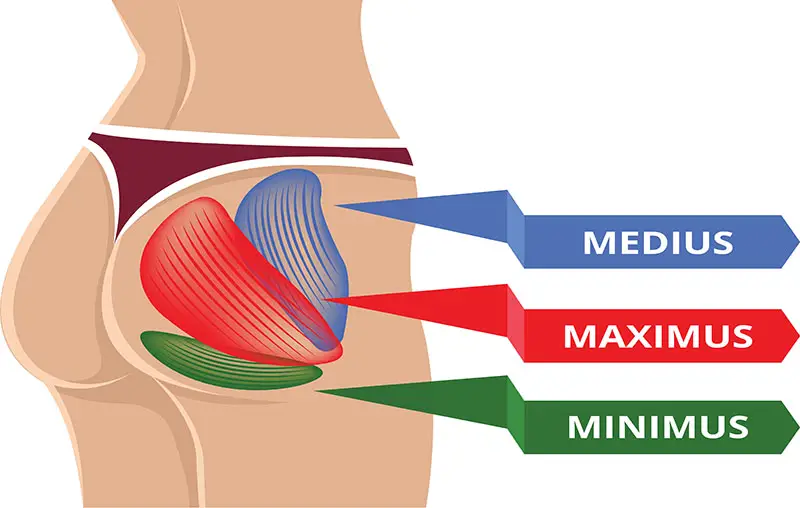The Cable Glute Kickback
Contents
- The Cable Glute Kickback
- What is a Cable Kickback?
- Muscles Used During Cable Glute Kickbacks
- Are Cable Glute Kickbacks Effective?
- Cable Kickback Benefits
- How to do Cable Glute Kickbacks
- Cable Glute Kickback Variations
- Cable Kickback Alternatives
- Adding Glute Kickbacks to Your Workout
- Cable Glute Kickback Tips
- Common Cable Glute Kickback Mistakes
- Cable Glute Kickback FAQ’s
Let’s talk about leg day – or more importantly, glute day. My favorite day (or days, depending on my mood) of the week!
And for those who aren’t a fan of working out lower body, it’s time to reevaluate that.
There are a slew of benefits that accompany leg day like the fact that working out your legs helps to produce hormones including testosterone and cortisol.
Not to mention working out your lower body also:
- Builds and tones your muscles
- Strengthens your core
- Increases your balance and stability
- Reduces joint pain
- Eases lower back pain
- Manages stress levels
- Improves posture
- Boosts brain health
As I mentioned above, working the glutes is one of my favorite days of the week.
While there’s a large variety of glute workouts to do, one of my all-time favorites is cable glute kickbacks.
Any exercise using cables can be pretty challenging and a good way to intensify your workout.
But there’s not much that satisfies me more than the burn of cable glute kickbacks.
What is a Cable Kickback?
First things first, what is a cable glute kickback?
The quick answer: one of the best glute exercises you’ll ever do.
But to put it more in depth, you do a cable kickback with a cable machine while targeting the gluteal muscles.
You’re probably thinking about the fact that squats do the same thing.
And while squats do work the glutes, they don’t isolate the muscles as well as cable glute kickbacks.
Muscles Used During Cable Glute Kickbacks

Cable glute kickbacks get their name from working the three gluteal muscles.
- Gluteus Maximus
- Gluteus Medius
- Gluteus Minimus
However, they work more than just those.
In fact, cable glute kickbacks work a pretty broad range of muscles such as your core, hamstrings, calves, quads and lower back.
While these secondary muscle groups may not receive the brunt of the work, they are engaged and will help tone those areas.
Are Cable Glute Kickbacks Effective?

Are glute kickbacks really worth all the hype? Why, yes, they are.
Cable glute kickbacks are extremely effective in shaping and toning your gluteal muscles and legs – especially the hamstring area.
Cable kickbacks target the area where the hamstrings meet the glutes, which helps to create a rounder, fuller bum!
Cable Kickback Benefits
This might be a shot in the dark here, but I’d say a majority of people want to have a nice bum.
As the name implies, cable glute kickbacks are an extremely effective exercise for building, toning and shaping your buttocks.
But there are additional benefits to cable kickbacks.
Strengthens
One of those benefits being the fact that strong glutes = a strong core = a strong back.
According to celebrity trainer, Sara Lewis, all the muscles in your body work together—that’s why you can’t spot reduce or strengthen just one muscle at a time. And three areas that work together a lot are your core, your butt, and your lower back.
So, by doing cable kickbacks you’ll be keeping your back and core strong too!
Isolates
The gluteal muscles can be hard to isolate.
It’s common when doing other lower body exercises, like squats or lunges, that your glutes don’t get as much action as the quads or calves.
This is because when performing an all-inclusive lower body exercise, the larger muscle groups are more likely to overcompensate for the smaller muscles.
Which makes sense, you would expect your stronger muscles to carry most of the load!
However, cable glute kickbacks allow you the ability to isolate and target the glute muscles specifically.
Balance & Stability
When performing cable glute kickbacks, your leg moves behind you in a “kicking” motion.
This causes other areas of the body to engage in order to stabilize your body, which improves the control of your body.
Improving the control of the body leads to better balance and stability.
How to do Cable Glute Kickbacks
So, how do you perform a cable glute kickback?
First, you’ll need a cable machine and an ankle cuff.
A majority of gyms have these available, so if you don’t quite know what you’re looking for, be sure to ask.
Once you’ve got your cable machine and ankle cuff attachment, you will need to:
- Set the pulley system to the lowest possible setting and attach the ankle cuff to your ankle.
- Hinge from the waist and bend over so your back is almost parallel to the floor. If you need some additional stability, you can hold on to the cable machine.
- Keep a micro-bend in your planted leg, engage the abs and contract the glute muscles to lift your other leg back, slow and controlled, as far as possible.
- Squeeze the glutes at the top and slowly lower back down to the starting position.
- Repeat the exercise as many times as you desire on each side.
- If you are doing less weight, shoot for doing 3-4 sets of 12-15 reps.
- If you are using heavier weight, try doing 6-8 repetitions.for 3-4 sets.
Cable Glute Kickback Variations
Here are some different kickback variations you can try.
Glute Machine

This machine is like the cable kickbacks, except it’s done on a machine and no cables.
There are various styles of glute machines. On some, you sit and push an arm down with your leg.
On others, you stand and the motion mimics a cable glute machine.
Cable Kickback With Abduction
A cable kickback with abduction puts the emphasis on your gluteus medius and minimus.
The exercise is the same as a regular kickback, except when performing the kickback, turn your body 90 degrees to the cable machine and lift your leg to the outside.
Remember to squeeze at the top and slowly lower back down!
Resistance Band Glute Kickback
- Ultra Effective Glute and Butt Workout - Build a harder, rounder, bigger booty with the all in one Glute-Tastic latex rubber workout bands set. Build your legs, hips, and calves with our guided...
- Premium Comfort and Strength - Our ankle resistance bands with cuffs are the most comfortable design on the market, which supports more intense workouts that create results. The Glute-Tastic has wide...
- Portable and Lightweight - This set is compact but mighty. Use it at home, or bring it to the gym, office, or throw it in your suitcase for easy travel. The kickback ankle strap set comes with...
- Simplify Exercise - Fitness training in simple steps starting with the ankle workout equipment. The door resistance bands or the fitness resistance bands with cuff will act as a cardio starter for men...
- Satisfaction - All of Core Prodigy’s products are designed to last. Each product is inspected with the highest quality standards. If you are unhappy for any reason, we will make it right.
If you don’t have access to a gym that has a cable machine, you can still do glute kickbacks using a resistance band that can be purchased just about anywhere.
Connect between a door and a door frame and do your glute kickbacks!
Cable Kickback Alternatives
Not sure if you’re ready to take on cable kickbacks? Here are some alternatives that you can try.
Donkey Kicks
Start on all fours with your hands positioned under the shoulders.
Engage the core and extend one leg backwards as far as you can go.
Squeeze your glutes, then lower back down to the starting position.
Hip Bridges
Lay down on your back with your arms by your side, bend the knees and face the palms down.
Contract the glutes to lift your hips off of the floor as high as you can lift them.
Contract the muscles at the top, then slowly lower back down and repeat.
Leg Back Toe Down Pulses
Start on all fours with the hands directly underneath the shoulders.
Extend one leg straight behind you, keeping the toes facing down.
Squeeze the glutes to pulse the leg in an up and down motion.
Continue the pulse for your desired number of repetitions and switch.
Adding Glute Kickbacks to Your Workout
If you’ve never tried cable glute kickbacks before, let’s explore why you should add them to your workouts and how you could go about that.
Why?
If the benefits listed above weren’t enough to convince you, there are even more reasons you should add glute kickbacks to your workout.
Not only does it tone and build your muscles, increase your balance and stability, ease lower back pain, and boost your brain health, it’s also a great way to mix up your typical routine.
Mixing up your routine and trying new exercises like cable glute kickbacks can prevent injuries from overuse, prevent burnout in your workouts, and break through progress plateaus.
How?
Maybe you are feeling convinced to give cable glute kickbacks a try, but you’re not exactly sure how you should incorporate them?
Well, that’s easy.. My best advice is to start small.
If you are the type to have “leg days” and “arm days”, simply incorporate this movement into your leg day.
If you don’t, maybe you could simply try it the next time you’re at the gym.
For those that don’t have access to a gym with a cable attachment, you could always try them free of resistance or with a resistance band.
This could allow you to practice nailing down the technique before committing to buying equipment, etc.
Cable Glute Kickback Tips
If you’re just adding cable glute kickbacks to your workout routine, here are my top three tips for ensuring the exercise is a success…
Secure Your Cable
If the cable you are using is an attachment and not a feature on a machine, you need to make sure it is secure before getting started.
Once you have it secured, make sure it fits snuggly around your ankle.
The last thing you need is the cable popping off and injuring you or others around you.
Quality over Quantity
Because cable glute kickbacks are an isolated movement, you will see best results when you take your time and focus on your form.
Some exercises do best when you are pumping out reps, but you’ll do best with this exercise when you focus on the quality of each rep over the quantity.
Listen to Your Body
If you’re new to any exercise, it’s important to first talk with your doctor and make sure you’re clear to give it a go.
Once you’ve got the “go ahead,” make sure you continue to listen to your body.
Because you are targeting a specific muscle group, if they’re not used to such focus, they may become extra sore.
The more you listen to your body, provide yourself with adequate rest & recovery, and stretch, the more you’ll reap the benefits.
Common Cable Glute Kickback Mistakes
Even with the tips listed above, people often make mistakes when they first start out. Be sure that when doing cable glute kickbacks, you avoid these common mistakes:
Standing Up Straight
More often than not, people will attempt this exercise while standing up straight.
Standing upright will hinder your range of motion and make it difficult to isolate the glutes.
Using Momentum
Another common sign of rushing through cable glute kickbacks is using momentum.
People who do this may complete the reps fully, but they’re relying on momentum to get them there.
To avoid using momentum, slow down. It’s important to use the glutes to lift the leg back, or you won’t get the booty gains!
Focus on controlling your leg down through the negative portion.
Incomplete Reps
When you’re doing a cable kickback, you’ve got to make sure you complete the rep fully.
Like my tip above, focus on quality over quantity.
Be sure that you can feel the tension in your glutes before lowering your leg back down.
Often, people will rush through their set. They halfway their reps, and lessen the overall benefits of the movement.
Cable Glute Kickback FAQ’s
Q: Are cable glute kickbacks good for your glutes?
A: Cable glute kickbacks are not only good for your glutes, but they are an exercise specifically designed to isolate your glutes.
As mentioned above, this exercise allows you to work on all three glutes: gluteus maximus, gluteus minimus, and gluteus medius all at once.
Cable glute kickbacks are not only good for your glutes, but they are an exercise specifically designed to isolate your glutes, making them the main focus!
Q: What attachment do you use for cable glute kickbacks?
A: There are a few different things to consider when you are selecting an attachment, but the most important thing to consider is how it attaches to you.
Some people prefer a simple ankle strap that secures with velcro around their ankle.
Other people like a little more security and want an ankle strap that includes a stirrup feature.
For the most secure feel, there are also complete foot harnesses.
There’s no right answer other than what feels good to you..
Q: What are the benefits for using a cable with glute kickbacks?
A: Using a cable is all about providing resistance.
It allows you to challenge yourself and customize your glute kickback in a way that helps your strength improve.
Of course, you can do glute kickbacks simply holding onto a chair in your living room if you’re new to the exercise.
But if you’re looking to take it up a notch, cables are a great way to do it.
Q: Can you get injured from doing a cable glute kickback?
A: As with any exercise or workout, there are always risks associated.
Before you do any workout, make sure you talk with your doctor and consult with a professional.
Make sure you are doing an appropriate amount of reps for your body and level of fitness.
If you pay close attention to proper form, you will definitely decrease your chances for potential injuries.
Q: How many cable glute kickbacks should you do?
A: Everyone is at a different age, weight, fitness level, and experience level.
So, the number of cable glute kickbacks you should do truly depends on these factors.
However, there are some common recommendations:
For the less experienced, you could try 3-4 sets of 8-12 repetitions if you are using little weight and resistance.
If you’re less experienced, but have selected to use a heavier weight, aim for only 6-8 repetitions per set.

